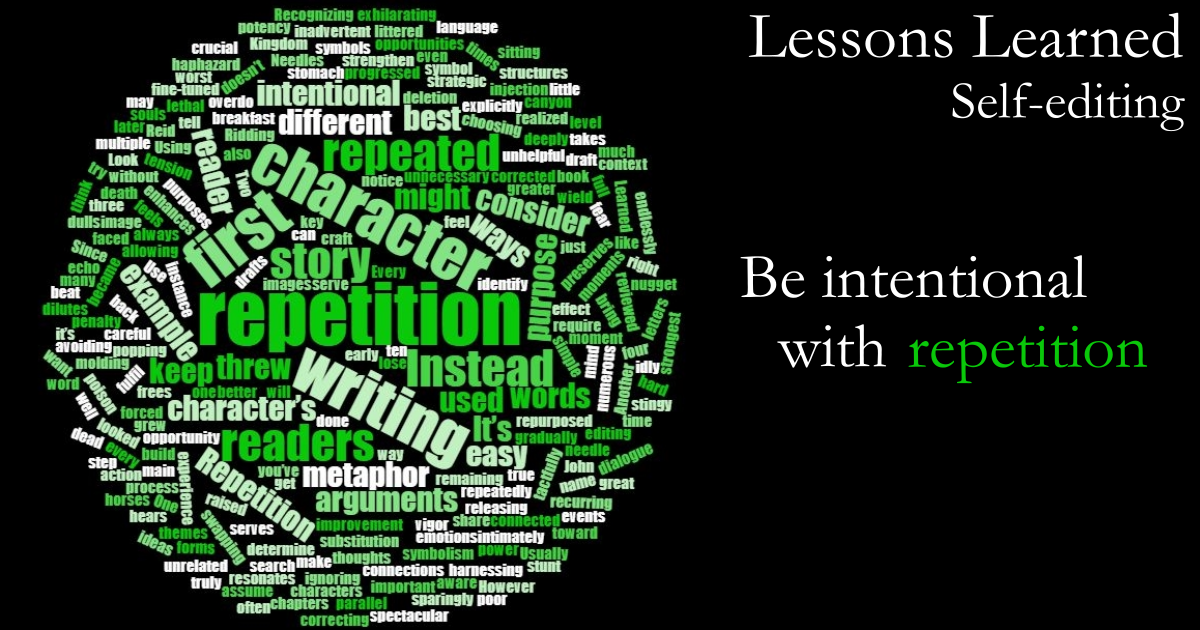Repetition takes many forms in writing: repeated words, parallel structures, recurring themes. At its best, repetition resonates like an echo in the canyon of readers’ souls. At its worst, it dilutes the potency of our language and dulls even the most exhilarating action.
The best poets, orators, and songwriters are often masters of repetition. But what about novelists? What kinds of repetition do you find in prose, and how do you get it right? I’d like to share with you a few things I learned about repetition while self-editing the early drafts of my debut novel.
Be Aware
Recognizing the repetition in your writing is crucial to harnessing its power and avoiding its poison. Since some of the repetition in writing is inadvertent, it is important to search for it during the editing process.
When I reviewed the first draft of The Kingdom vs John Reid, it was littered with haphazard repetition. Here are just a few examples:
- One character repeated his arguments three or four different ways.
- Another character threw up multiple times.
- Two different characters had the same full name.
Look for repetition at every level from letters and words to ideas and events. Awareness is the first step toward intentionality.
Be Stingy
It’s hard to have too little repetition in your writing, but it’s easy to have too much. When you think of a great word or phrase or stunt, you may naturally want to keep using it. This is often a mistake. The wonder of reading a truly surprising metaphor is cheapened when ten chapters later that same metaphor is used in an unrelated context. Usually, the more spectacular the nugget, the more sparingly it should be used.
This is true of dialogue as well. Instead of sitting idly by while my character endlessly beat dead horses, I fine-tuned the strongest of his repeated arguments and threw out the duplicates. It’s usually best to assume your readers hear you the first time.
However, correcting poor repetition doesn’t always require simple deletion or substitution. Repetition can also be tweaked for greater effect. Instead of allowing my character to lose his breakfast repeatedly, I gradually raised the tension in his stomach as the story progressed, releasing it only once, at a moment of careful choosing.
Ridding your writing of unhelpful repetition preserves its vigor and frees your readers to experience only the repetition that enhances your story.
Be Intentional
Every instance of repetition you identify in the early drafts of your writing is an opportunity for improvement. After you’ve corrected the unnecessary repetition, consider how you might craft the remaining repetition to better serve your purposes.
For example, you might notice images that keep popping up in your story. Instead of ignoring them or swapping them out, try molding them into symbols. Use them to make connections for your readers without having to explicitly tell them.
Needles became a symbol in my first book. For my main character, who faced the death penalty by lethal injection, needles grew intimately connected to his fear. Once I realized this, I looked for opportunities to bring this image back to his mind at strategic moments. It’s easy to overdo this in a way that feels forced, but if tactfully done, your reader will feel your character’s emotions or share your character’s thoughts more deeply.
Using repetition to build symbolism is just one example of the numerous ways to strengthen your writing through repetition. The key for all of them is to determine what purpose (if any) the repetition serves and how best to wield repetition to fulfill that purpose.
